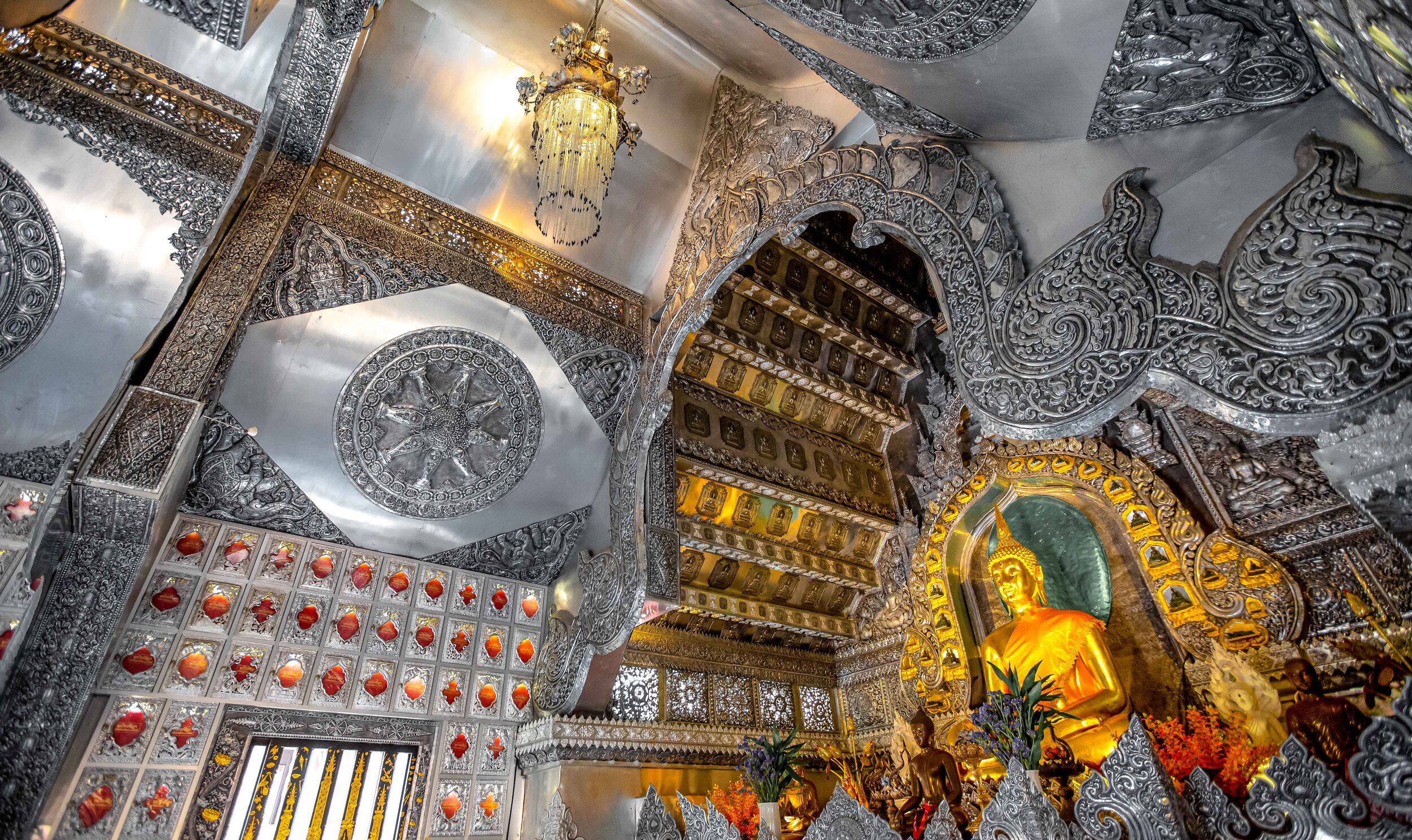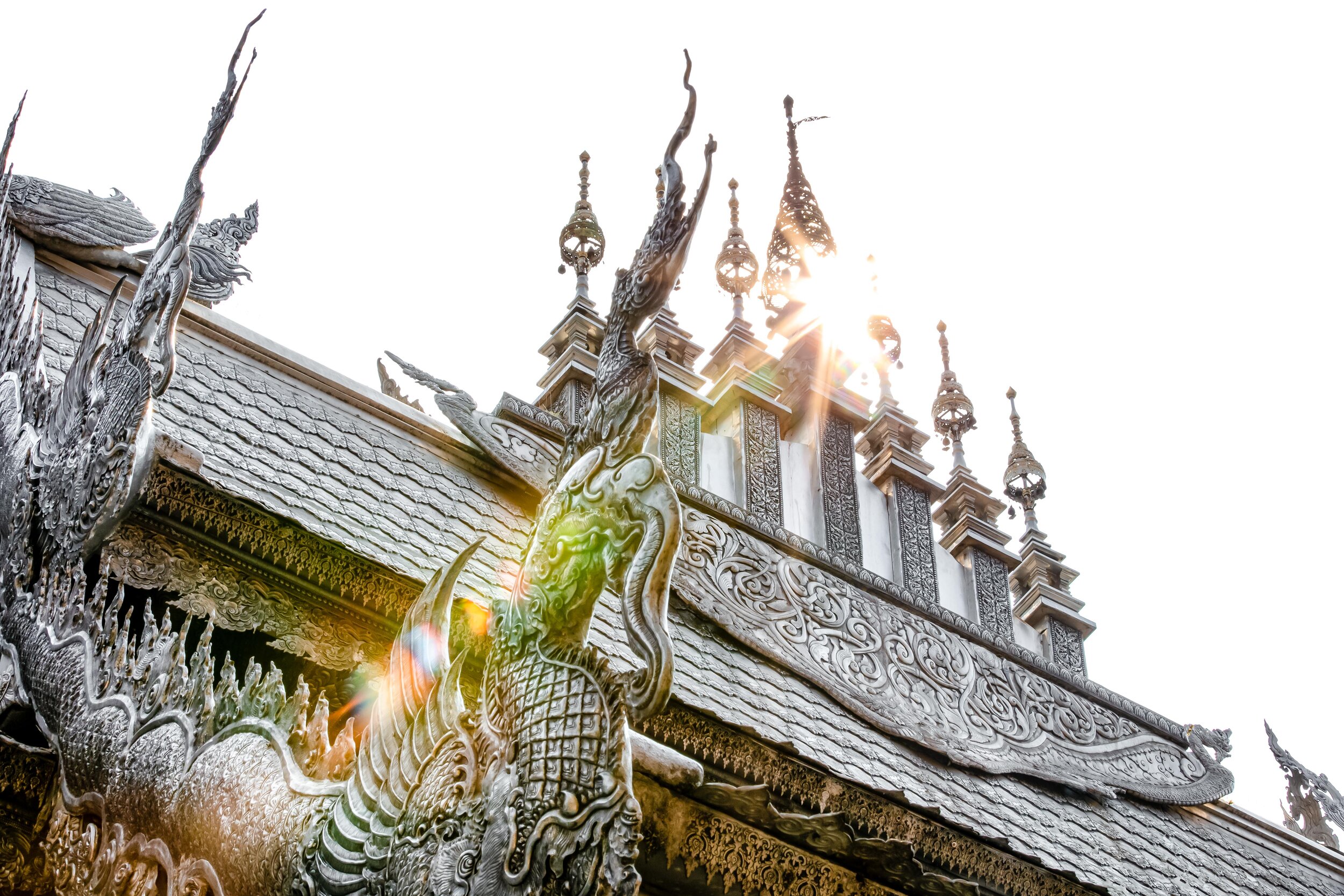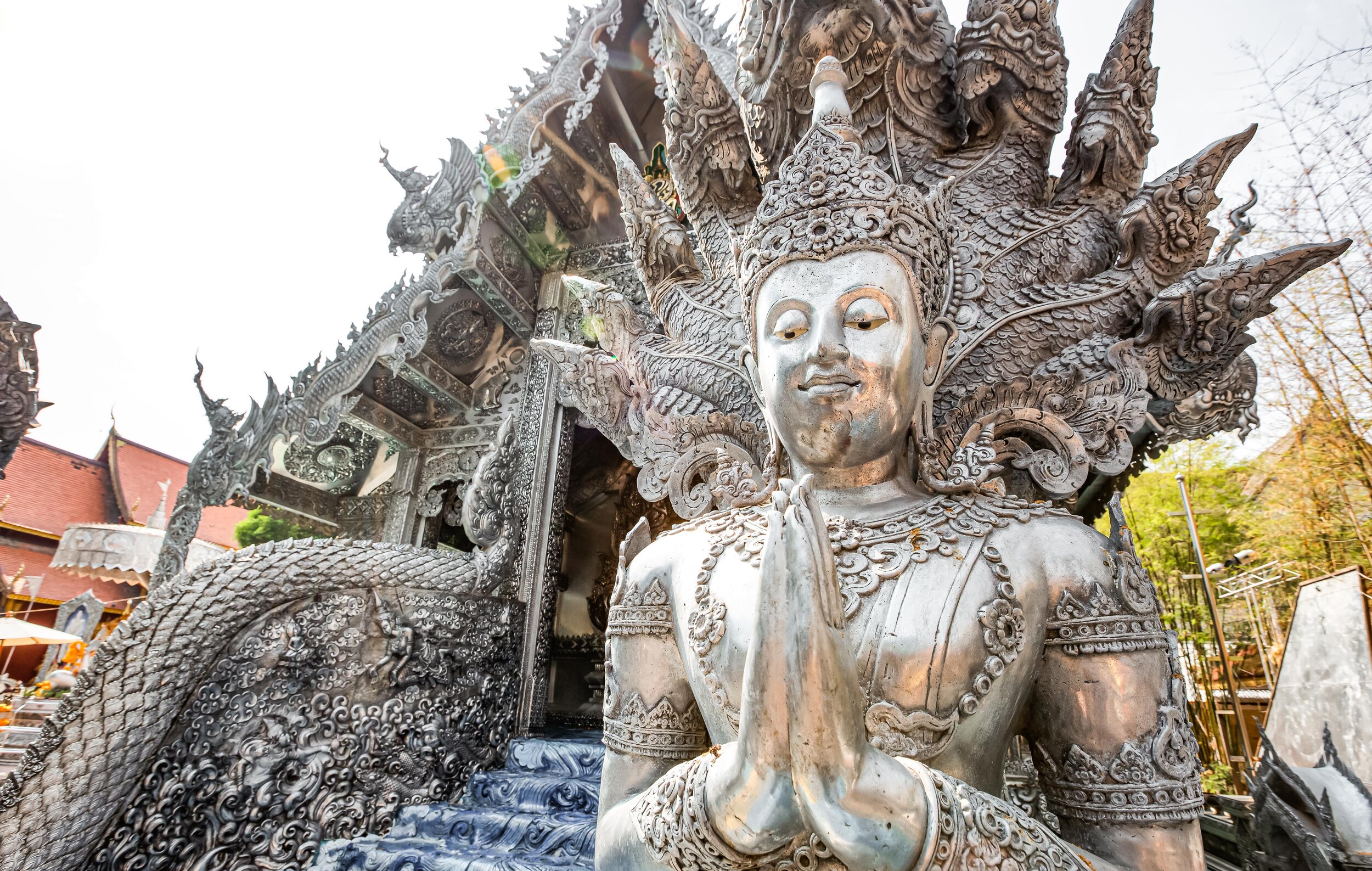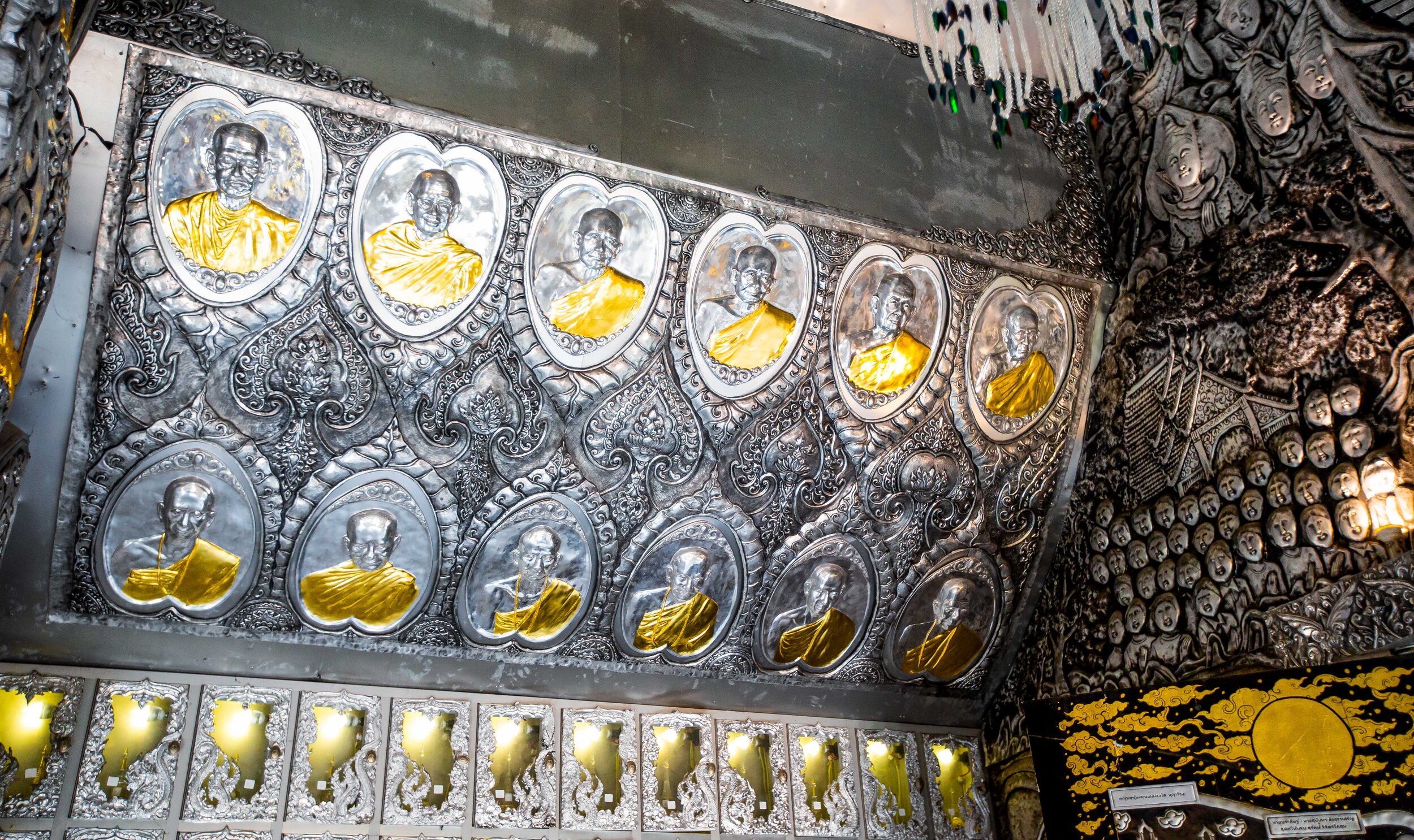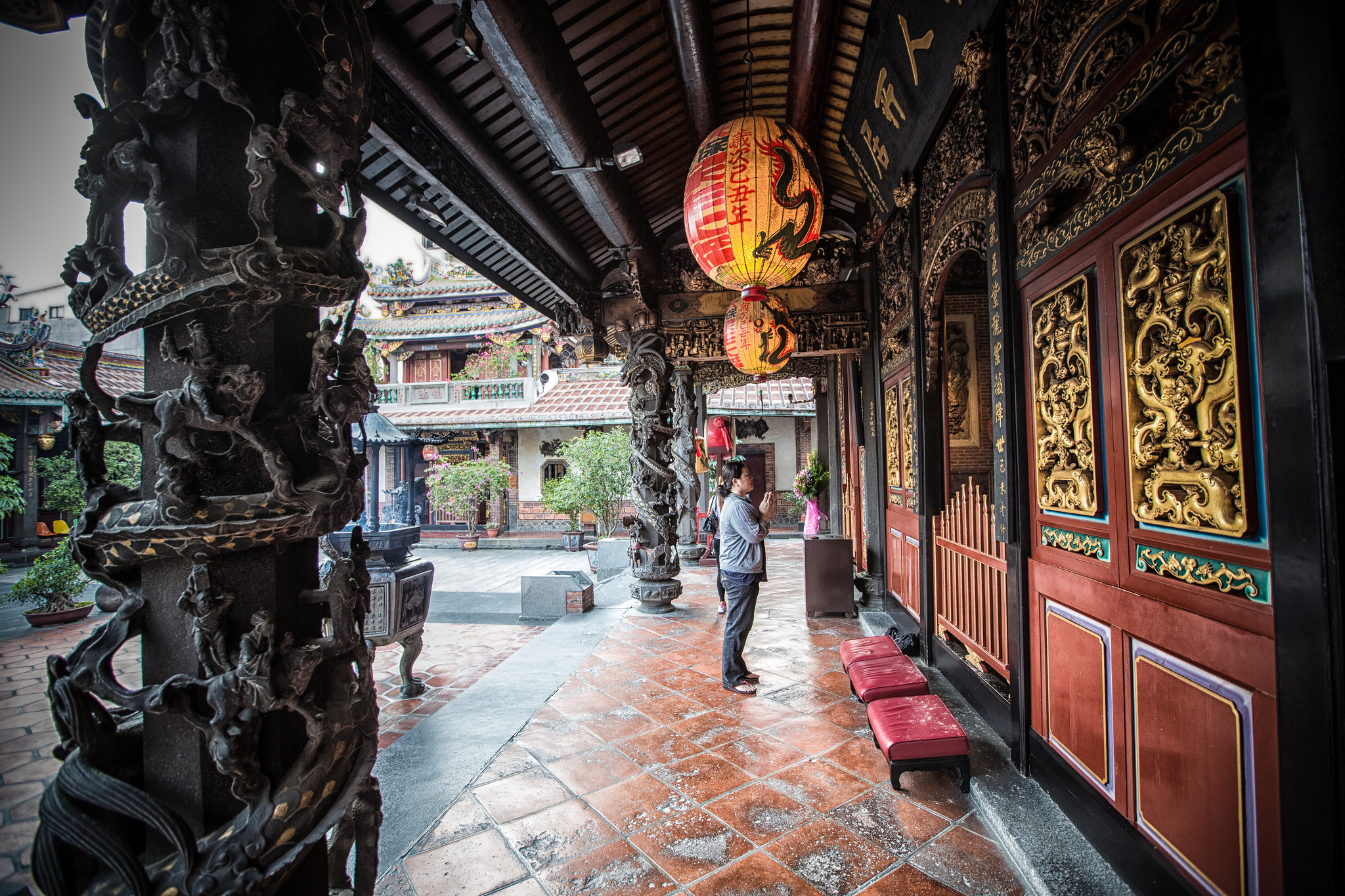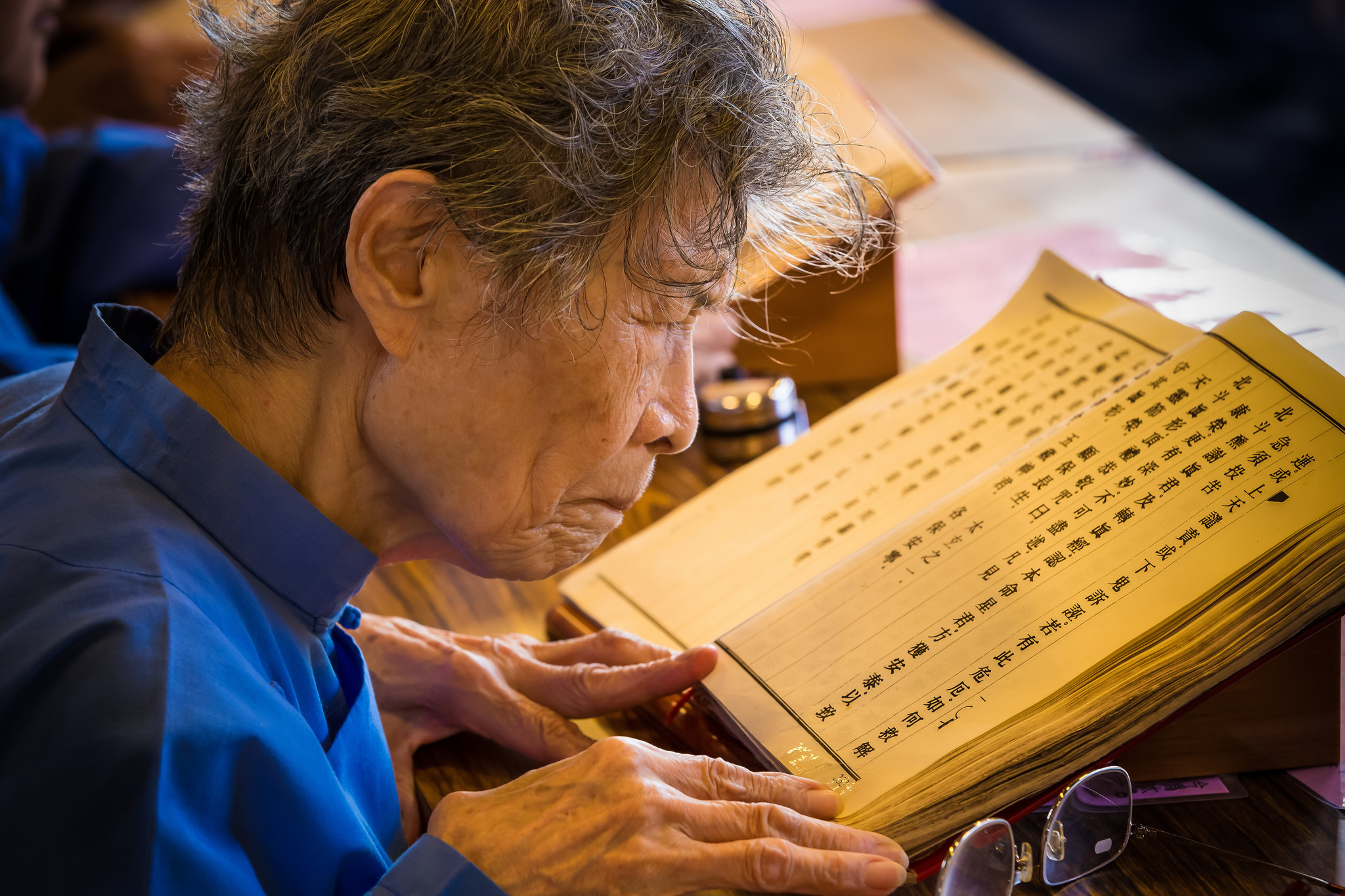Some authors like to start out with a quote, but instead, I’m going to start this one with a couple of not-so-random facts.
There are over three hundred ‘wats’ (temples) in Chiang Mai.
There are more places of worship per capita in Chiang Mai than anywhere else in Thailand.
Many, if not most of the temples in the area date between the 13th and 18th Centuries.
It goes without saying that there is a lot to see and do while visiting Thailand’s ‘northern capital’, but it shouldn’t really surprise anyone that one of the most popular activities for tourists is checking out some of the hundreds of temples in and around the city.
Sure, you can head to the night markets, eat amazing Northern-Thai cuisine and explore the beautiful streets of the ancient kingdom-turned-city, but lets face it, foreigners and locals alike are always going to be attracted to the giant ‘wats’ that you’ll find throughout the city and the countryside that surrounds it.
And with over three-hundred to choose from (and limited time), you’re going to have to choose wisely.
Obviously, almost everyone will find themselves checking out Wat Chedi Luang - It is after all one of the most important and historic places of worship in Thailand, and its conveniently located in the dead-centre of town.
Then there’s Wat Phra That Doi Suthep, the most popular and highly-revered temple in town, which also involves an exciting excursion into the mountains.
Fortunately there are quite a few resources online in the form of ‘top ten’ lists that introduce some of the most interesting places of worship in the area and are helpful for making decisions about which ones to visit during your stay.
Link: 10 Must-See Temples in Chiang Mai | Top 10 must-visit temples in Chiang Mai
When it comes to this kind of thing, I’m not really your average tourist.
Sure, I’ll check out some of the most popular wats, but I’m also going to reserve some of my time to check out some of the obscure ones too.
And you’ll have to forgive me if I’m wrong, but I don’t think there are any that are more obscure than Wat Sri Suphan, more commonly referred to as Chiang Mai’s Silver Temple.
You’re not likely to find any other places of worship in the area that look like they’ve been covered in layers of tinfoil and have your favourite Marvel superheroes etched on the walls.
Before I start though, its likely that some readers will feel somewhat overwhelmed with all the local terms that you’ll come across below. If thats the case, never fear, there’s a helpful glossary of terms that should help explain what you’ll find at Chiang Mai’s places of worship.
Link: A glossary of Thai Temple terms in 75 temples of Chiang Mai’s Old Town
Wat Sri Suphan (วัดศรีสุพรรณ)
The Haiya (หายยา) subdistrict, located just south of Chiang Mai’s historic quarter is a residential area that is known for its traditional silver workshops, which produce and sell artisan jewelry and ornaments.
When you build a temple in a neighbourhood famed for its silver craftsmanship, it probably only makes sense that you show off what you’re best known for, right?
Well, that wasn’t always the case.
Wat Sri Suphan was originally established in 1502 during the reign of King Mueangkaeo of the Lanna Kingdom’s Mangrai Dynasty.
In the five centuries since, the wat has been rebuilt on several occasions, leaving very little evidence of the original.
Before I go into much detail about the temple, I think it’s important to note that while “Wat Sri Suphan” is generally referred to as “The Silver Temple” in English, the “silver” part is actually only a small piece of a large complex that includes a much larger viharn (worship hall), residences and some other buildings.
The silver ubosot (ordination hall) part of the complex, which has become Wat Sri Suphan’s claim to fame in recent years, is a recent addition and was actually only completed in 2004.
What I’m getting at here is that while locals refer to this place of worship by its formal name, tourists are almost always going to call it, “The Silver Temple.”
It probably doesn’t really matter what tourists call it in English, but I think in some cases (admittedly I was originally under this impression too) people come looking for the Silver Ubosot and leave completely unaware of the actual historic and (arguably) more important parts of the temple.
Wat Sri Suphan Viharn
The grand viharn may not be as snazzy or attractive as the Silver Ubosot next door, but that doesn’t change the fact that it is the most significant building at Wat Sri Suphan and dates back more than two centuries, making it the oldest building on site.
The sad thing about this is that it is often overlooked by tourists who know very little about it (few articles online talk about it) or even bother to check it out while visiting, which is why I’ve elected to talk a little about it before I go into detail about the Silver Temple.
The large Lanna-style viharn features an impressive overlapping four-tiered roof with “Naga” serpents along the gables and “Garuda” chofas at the apex of each of the four tiers.
The building doesn’t have a hint of silver on the exterior and is instead a beautiful mixture of gold and red with an umbrella finial at the top.
The entrance is guarded by two of the most impressive naga serpents (that I saw while) in Chiang Mai with some green-skinned Yaksa guardians standing behind them.
Similar to the exterior, the interior of the building is finished almost entirely in red with only the upper parts of the walls, window shutters and columns decorated with golden patterns.
As is the case with a lot of Thai temples, you’ll find images of the Buddha’s life on the walls of the viharn, but in this case those traditional images have been replaced by silver panels that have been beautifully designed by local artisans.
The main altar in the viharn is a beautiful golden shrine that has a large Buddha, with three smaller statues surrounding him, all of which were crafted in the Northern Thai Chiang Saen style.
The interior of the viharn is quite simple, so it shouldn’t take too much time to check it out - but you should most definitely check it out if you are visiting the area.
Interestingly, while inside the viharn, one of the monks noticed that we had Taiwan-related pins on our bags and asked us if we were visiting from Taiwan. Coincidentally he had lived in the country for quite a while before heading to Thailand to become a monk.
We sat down and had a long chat with him in Mandarin while he braided a couple of bracelets for us, which was quite nice.
The “Silver Temple”
The “Silver Temple” is a modern interpretation of a traditional Thai Ubosot and is the most recent addition to the larger Wat Sri Suphan complex.
Even though it is a modern interpretation and was constructed using precious metals, its important to note that the building keeps with local tradition and makes use of the beautiful Lanna-style architecture that Chiang Mai is well-known for.
Construction on the ubosot started in 2004 under the direction of the abbot Phra Kru Phithatsuthikhun and was completed over a decade later in 2016. Just in time to be dedicated on the 720th anniversary of the founding of the city.
While not particularly a large building, the time it took to construct it shouldn’t really surprise you. It took a large team of silver craftsman to mould the silver into the beautiful work of art that you see today.
It also required a significant amount of donations.
Once completed, over 35,152,314 baht, equal to about $1,000,000 USD was spent constructing the building.
That being said, silver was only used for the most important elements of the temple whereas the vast majority of the building was constructed using aluminum, zinc alloy and nickel, which are cheaper and much more flexible.
When it comes to the intricate designs on the exterior and interior of the hall, its important to note that the majority of the work was done in a style known as repoussé and chasing - What this means is that large sheets of malleable metal were pushed from behind to form a design and then finished with the “chasing” technique from the front.
Link: Repoussé and chasing (Wiki)
If you spend some time walking around the Haiya District of Chiang Mai, you’ll likely hear the constant tapping of hammers on silver with artisans crafting art to be sold in local markets.
Likewise, you’ll also find a small workshop on the temple grounds where there is a resident master silversmith observing the work of the apprentices, who are helping to keep the ancient local tradition alive.
I might be beating a dead horse here but as I’ve already mentioned, the various buildings that make up Wat Sri Suphan have had to be rebuilt on several occasions over the past few centuries.
The Silver Temple that we see today just so happens to have been constructed on top of a previous non-silver ubosot.
All that remains of the original is the base and the sacred ‘sema stone’ boundary markers that signify the separation of the ‘sacred’ and ‘profane’ perimeter of the ubosot.
While this might not seem all that significant, it is tradition in Thailand that amulets and holy relics are buried under the base of an ordination hall before its construction.
The ‘sema stones’ that remain today from the original building were buried there around five centuries ago and this is one of the reasons used to explain why women aren’t permitted to enter the Silver Temple.
I’ll talk more about that later.
Link: Bai Sema (Wiki)
The only other truly historic part of the Silver Temple is the beautiful ‘Phra Jao Jed Tue’ Buddha statue that occupies the main shrine and is probably one of the only aspects of the interior that isn’t silver.
The statue is thought be at least five-centuries old and there are claims that it was cast in the year 1500, which actually predates the temple.
It certainly doesn’t look that old. It’s absolutely beautiful.
The Head-Scratching Design
A lot can be said about the mastery and genius that went into constructing this truly unique temple, but some of the decisions when it comes to the murals on the interior and exterior are quite a head scratcher.
Taking into consideration that over a million US dollars was spent to construct the temple - its kind of amazing how much free reign artisans were given to come up with the decorations for the building.
As I’ve already mentioned, when you visit the temple, it’s important to spend some time checking out all of the small details, because if you do, you’re certainly going to discover that this is where it becomes truly unique - It will also likely make you wonder what the actual thought process was behind some of the artistic decisions.
Starting with the more traditional aspects of the design, the front of the hall is guarded by two “deva” figures on either side of the entrance. They are protected overhead by multi-headed serpents which are representations of Mucalinda, the king of the naga serpents, which protected the Buddha while meditating under the Bodhi tree.
Link: Mucilinda (Wiki)
Following Lanna tradition, the roof consists of three overlapping tiers, each of which features nagas running along the gables. At the apex of each of the tiers, you’ll find “chofas” (ช่อฟ้า), which are representations of the Hindu bird-god Garuda. Finally at the top you’ll find a finial with seven gilt umbrellas, which symbolize the universe.
As is the case with many of Thailand’s temples, you’ll find images on the exterior inspired by the Jātaka tales, a collection of more than five-hundred stories detailing the many lives of the Buddha prior to attaining enlightenment, in addition to other religious figures common in Buddhism and Hinduism as well as the Thai Zodiac.
These images are displayed on the larger open parts of the exterior walls and occupy most of the space.
Link: Jataka Tales (Wiki) | Jataka Tales (Buddha Net)
You’ll find the pièce de résistance on the rear wall of the building, which is the most intricate and beautifully designed murals on the entire building and tells the story of an important event in Buddhist lore.
Directly in front of building you’ll find two large images of the Buddha on either side of the entrance, one cast in silver while the other is gold. To the left of the building you’ll also find a beautiful silver statue of the Hindu god Ganesha with a silver parasol above its head.
Even though Ganesha is one of the most important gods in Hinduism, the deity was introduced to South East Asia centuries ago and is widely revered in Thailand as a patron of the arts and sciences.
Interestingly, the parasol above Ganesha’s head is decorated with the twelve animals of the Chinese zodiac, offering more evidence that the design of this temple is a cultural melting pot.
Where things start to get a little odd is in the smaller details where a certain level of international solidarity is put on display with images of many of the worlds major cities and their most famous landmarks.
There is also quite a bit of love shared for neighbouring ASEAN Nations such as Singapore, Vietnam, Myanmar and others.
As it is claimed that this is the first place of worship crafted out of silver, it seems like the designers took some liberties in comparing their silver masterpiece to some of the other architectural feats of human civilization, so you’ll find shoutouts to the other ‘Wonders of the World’ with depictions of the Great Pyramids of Giza, the Statue of Zeus at Olympia, the Colossus of Rhodes, etc.
There’s even a mural dedicated to the superheroes of the Marvel universe striking a pose.
My only question is: Where’s the Silver Surfer?
While you might think that a Buddhist temple featuring Spider-Man and Captain America on its exterior is strange, the interior is where you’ll want to pay the most attention.
At the entrance to the temple you’ll find an image of the much-loved former King Bhumibol in the form of a 1,000 Thai Baht banknote as well as a wide-range of Buddhist and Hindu images and mythical creatures.
Keeping with tradition, the walls of the interior feature images of the Buddha’s life as well as other important religious figures with links to the temple.
The floor though is where you’ll want to pay the most attention.
The floor is modelled somewhat like a map of the earth with all of the continents connected by a network of the ancient zodiac.
Traveling around the planet you’ll find a group of aliens in UFOs who seem to be quite content with everything they’re seeing on their trip around our home planet.
Why are there aliens in UFOs checking out the earth on the floor of this temple?
Who knows - There isn’t really much of an explanation about that.
The only ‘explanation’ I’ve seen is that the interior of the building is thought to resemble a Buddhist temple from space or a space ship.
The strange designs shouldn’t really surprise you that much as there are quite a few recently constructed places of worship in Thailand that feature oddly placed, yet modern images that we’re all familiar with.
So, if you’re visiting a newer temple in Thailand, don’t be surprised if you find images of Astroboy, Doraemon, Hello Kitty, Godzilla, superheroes, Disney characters, etc.
The “White Temple” in nearby Chiang Rai for example has a mural of the attack on the New York Twin Towers on September 11th, which tends to irritate American tourists.
Link: Tourist’s shock at Thai Temple which has mural of planes hitting the Twin Towers (Daily Mail)
Do the aliens in UFOs have any relation to Buddhist cosmology or local Thai beliefs? Not really. But it is thought that their journey is meant to be a metaphor for your GPS to life.
That’s certainly open to interpretation though.
Female Visitors
If Wat Sri Suphan’s claim to fame is its Silver Temple, its safe to say that it has also become quite infamous (especially with foreign tourists) for how it deals with female visitors.
To put it simply, the interior of the Silver Temple is off-limits to women.
Why is it off-limits to women? That’s not really explained in much detail on-site.
There’s a big sign in front of the temple that reads: “Women are not allowed entering ordination hall’s area” and another in caps that reads: “WOMEN ARE NOT ALLOWED TO ENTER SILVER TEMPLE”
From the literature you’ll find online there are a number of explanations for this:
The hall contains holy relics which would be disturbed by the presence of women.
According to traditional Lanna culture, women are not permitted in buildings like this.
The Silver Temple is an Ordination Hall for monks and thus women are not be permitted as it could cause a monk to unintentionally violate their monastic vows.
Link: Restricted Area for Women in Thailand (Wikigender)
If you’ve done any research about this temple, you’ll likely have seen a bunch of bloggers complaining about this and of course they make some good points - Banning an entire gender these days (or at any time) makes little to no sense.
That being said, I’m not from Thailand and as a visitor to the country, it’s not my place to be imposing my values. As tourists, its important that we practice ethical-travel and ensure that we are doing our best to make sure that our tourism dollars are helping to empower women and local communities.
What we probably shouldn’t be doing though is losing our minds.
It’s important to remember that women are not banned from the entire temple, nor are they banned from the much larger viharn. They’re only prohibited from the ordination hall, which is a sacred space for monks and is where their ordination ceremonies take place.
In Thailand, monastic vows clearly state that monks are forbidden from touching or coming close to women’s bodies and this is strictly enforced upon those who have taken the vows.
If you take it into consideration that Thailand is one of the few Buddhist countries in the world where monks maintain (somewhat of) a traditional lifestyle, its important to make an attempt to understand why things are like this, even though we may not agree.
There are quite a few places of worship in Thailand where this unfortunate practice takes place, but in this specific case, the ordination hall is the claim to fame for this temple and it goes without saying that every tourist who visits would love to be able to go in and check out the interior.
Does it suck? Yes, it does.
While Thailand remains a country steeped in tradition, it is also quite progressive in many ways and women are afforded equal rights and high status in society. Local women’s rights groups likewise are also extremely vigilant in their effort to improve their status and have been successful in creating positive change and increasing their role in political activism and social movements.
Like every other country in the world, there are of course still a number of issues that need to be rectified to ensure full gender equality and these religious restrictions are something that have been discussed for quite some time.
It continues to be a work in progress though.
The good news is that Wat Sri Suphan isn’t the only “Silver Temple” in town and the other one, Wat Muen San, has absolutely no problems with women, and is only a ten minute walk away!
Wat Muen San Address: 13 Wua Lai Rd, Haiya Sub-district, Mueang Chiang Mai District, Chiang Mai 50100, Thailand
Getting There
Address: Wua Lai Rd, Tambon Hai Ya, Mueang Chiang Mai District, Chiang Mai 50100
Chiang Mai’s Silver Temple is located south of the historic quarter of the city and just so happens to be on the same road that where the popular Saturday Market is located.
Getting to the temple is rather straight forward but depending on where you’re staying, it might be a long walk, so you might want to have access to a bicycle or a scooter to get there.
Google Maps estimates that the temple is a 17 minute walk from Wat Chedi Luang and an eight minute walk from the southernmost exit of the historic district.
To get to the temple you’ll want to cross the southern traffic exit of the historic city to Rat Chiang Sean Road and then make a turn on Wua Lai Road.
This is the same road where the immensely popular Saturday Night Market is located, so you shouldn’t have much trouble finding it.
From there you’ll simply continue heading south until you come across an alley on the right side of the road that has a gate (and tourist signs) that lead you to the front of the temple.
Personally, I had a rented bicycle that I used to get to the temple as I was staying in the North-Eastern area of the historic district. From the southern exit of the city it only took about three or four minutes to get there.
If you are riding a bicycle or a motorcycle, you won’t have to worry as there is more than enough parking in the area that you shouldn’t have any difficulty finding a spot to park.
Understandably, it gets quite hot in Chiang Mai, so if you don’t feel like walking or riding a bicycle, you can easily grab a taxi, Tuk Tuk or Songthaew.
Link: 13 Ways of Getting Around Chiang Mai (Chiang Mai Traveller)
While in Thailand, you should also download the “Grab” app for your phone. It is basically South East Asia’s version of Uber but it allows you to easily grab a taxi, tuk tuk or motorcycle during your travels without having to worry about confusion or being taken for a ride.
Likewise, Thailand also uses Uber, so you have quite a few options available for getting around.
Admission: 50 Baht ($1.50 USD)
Hours: 6.00am - 5.30pm daily (Closes at 9:30pm on Saturday)
I should also mention that like many other places of worship in Chiang Mai, Wat Sri Suphan offers monk-chat and meditation sessions every other day. If you’re interested in taking part, the chats are held on Tuesday, Thursday and Saturday evenings from 5:30 - 7:30pm and the meditation sessions are held from 7:00 - 9:00.
Visiting a bunch of seven or eight-hundred year old temples is a fun learning experience and it goes without saying that Thailand’s wats are extremely picturesque, but after seeing a few of them, it would be understandable if you’ve started to feel a little worn out.
If thats the case, I highly recommend a visit to the Silver Temple.
I realize that if you’re tired of temple-hopping that visiting another might not exactly be the solution to your problem.
In this case though, you’re going to see something unlike any of the other places of worship in town (or anywhere) and while part of the temple complex is quite old, the Silver Temple is about as modern of an interpretation as you can get.
The temple of course has similar architectural design aspects as the other temples around town, but the liberties that they’ve taken with the artwork on the walls as well as the fact that the temple is entirely made out of silver and aluminum makes this one quite unique.
It’s also likely to lead you to think that designers probably had a few too many drinks while constructing the temple.
I promise, if you take the time to visit this temple and check out some of the smaller details on both the interior and the exterior, you’ll probably find yourself scratching your head wondering what is actually going on.
There isn’t a whole lot here that makes sense and that’s probably what makes a visit to this temple so much fun.


